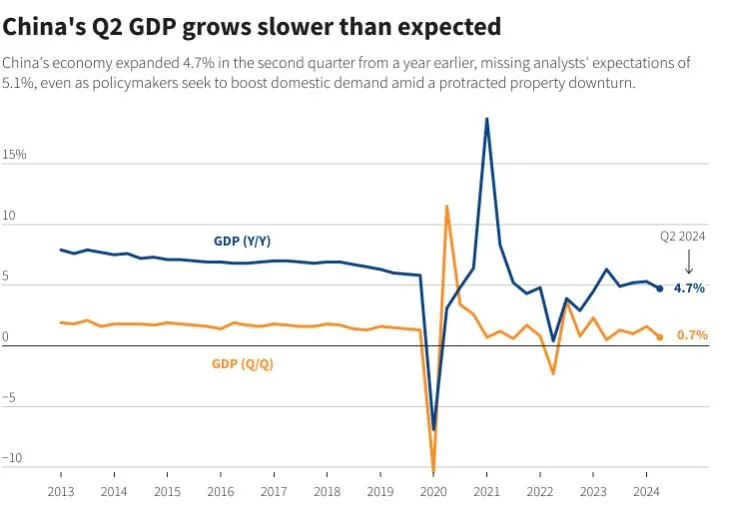China’s economy, the second largest in the world, is currently experiencing significant challenges. Recent data shows that economic growth has slowed more than anticipated, causing concern among economists and policymakers. The primary issues include a sluggish growth rate, a persistent property downturn, and weakening consumer confidence. As a result, there is increasing pressure on Beijing to implement further stimulus measures to stabilize the economy.
Slower Than Expected Growth of China’s economy

Source- Reuters
In the second quarter of 2024, China’s economy grew by 4.7%. This figure is significantly lower than the 5.1% forecasted by analysts. Moreover, it is also a decrease from the previous quarter’s 5.3% growth. This slowdown in economic growth is the slowest since the first quarter of 2023. Various factors contribute to this deceleration, but two primary culprits are the protracted property downturn and job insecurity among Chinese citizens.
Property Downturn and Consumer Confidence
The property sector, a crucial pillar of China’s economy, has been in crisis for years. In June 2024, new home prices fell at the fastest pace in nine years. This decline has severely impacted consumer confidence, leading to reduced spending and economic activity. As property prices drop, the wealth effect diminishes, causing people to spend less on big-ticket items. Instead, they focus on basic necessities such as food, drinks, and entertainment.
Stimulus Measures and Economic Growth Target
To counter these challenges, the Chinese government has been implementing various stimulus measures. However, these efforts have not yet yielded the desired results. The economic growth target for 2024 is around 5.0%, but many analysts believe this goal is ambitious. To achieve this target, more robust policy support is essential. Goldman Sachs recently revised its growth forecast for China down to 4.9% from 5.0%.
Weak Retail Sales Growth affecting China’s economy

Source- Reuters
One of the most concerning indicators of China’s economic troubles is the sluggish retail sales growth. Retail sales grew by only 2.0% year-on-year in June 2024. This rate is the slowest since December 2022 and falls short of expectations. The weak retail sales growth reflects low consumer confidence and spending power. Various industries are slashing prices to attract customers, indicating deflationary pressures in the market.
Challenges in the Property Sector
The property sector’s problems are not just limited to falling prices. Property investment fell by 10.1% in the first half of 2024 compared to the previous year. Additionally, home sales by floor area declined by 19.0%. These figures highlight the depth of the crisis in the property market. Local governments, heavily reliant on land sales for revenue, are struggling to generate fresh funds, further constraining economic activity.
Infrastructure Investment and High-Tech Manufacturing
In response to the economic slowdown, China has increased infrastructure investment and funneled funds into high-tech manufacturing. These sectors have shown some resilience, providing a buffer against the overall economic downturn. However, these measures alone are insufficient to offset the broader challenges facing China’s economy.
External and Domestic Pressures on China’s economy
China’s economy faces a myriad of external and domestic pressures. Bad weather in the second quarter impacted growth, but broader issues such as rising trade tensions and domestic difficulties are more significant. Industrial output has outpaced domestic consumption, raising deflationary risks amid the property downturn and mounting local government debt.
Factory Output and Trade
Despite the overall slowdown, some areas of China’s economy have shown strength. Factory output growth beat expectations in June 2024, although it slowed compared to May. This trend suggests that manufacturers are frontloading orders to avoid tariffs from trade partners. Exports in June 2024 increased by 8.6% year-on-year, while imports unexpectedly shrank by 2.3%. These figures indicate that external demand remains a crucial support for China’s economy.
Bank Lending and Monetary Policy
Bank lending data for June 2024 showed a faltering demand for credit, with some key gauges hitting record lows. To address weak domestic demand, China’s central bank has pledged to maintain a supportive monetary policy stance. Analysts expect a 10-basis points cut in the one-year loan prime rate and a 25-basis points cut in banks’ reserve requirement ratio in the third quarter of 2024.
Property-Supporting Measures
The government is expected to introduce more property-supporting measures following a key economic leadership meeting. In May 2024, authorities allowed local state-owned enterprises to buy unsold completed homes. The central bank also set up a 300 billion yuan re-lending loan facility for affordable housing. These measures aim to stabilize the property market and boost consumer confidence.
China’s economy-The Road Ahead
The road to achieving the economic growth target of 5.0% for 2024 remains challenging. Economists and policymakers agree that more stimulus measures are necessary. However, implementing these measures without exacerbating other issues, such as mounting debt, is a delicate balancing act. The government’s approach will likely be cautious, aiming to shore up growth without triggering further economic instability.
Conclusion
China’s economy is at a critical juncture. Sluggish growth, a persistent property downturn, and weakening consumer confidence are significant hurdles. While stimulus measures are in place, their effectiveness remains to be seen. The economic growth target of 5.0% for 2024 is ambitious, and achieving it will require careful and strategic policy interventions. As the global economic landscape continues to evolve, all eyes are on China to see how it navigates these challenges and stabilizes its economy.
Click here to read our latest article Zelenskiy Demands NATO Support

